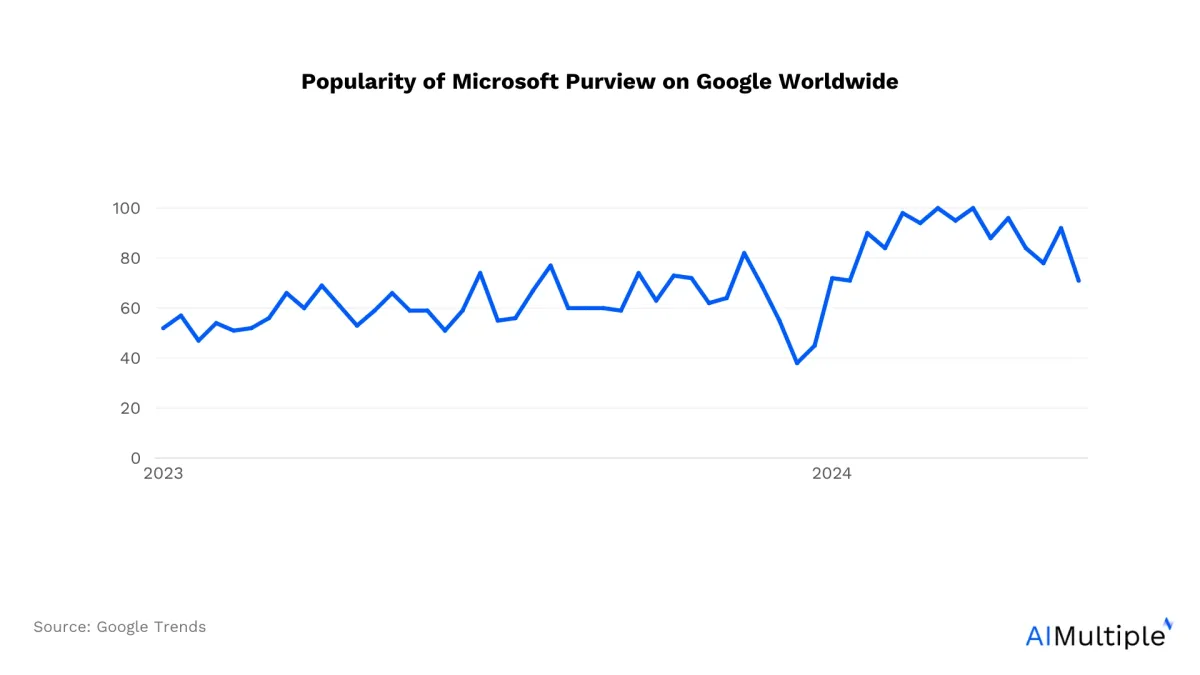Though Microsoft Purview is a popular DLP software, it can be hard to use and provides limited policy customization options. We analyzed the top 6 DLP products across four dimensions to identify the top Microsoft Purview DLP alternatives. See their features, strengths, and weaknesses:
Comparison of the top 10 alternatives
Features
| Software product | USB control & encryption | Data classification | Multi-OS | On-prem deployment |
|---|---|---|---|---|
| Microsoft Purview Data Loss Prevention | ✅ | ✅ | ✅ | ❌ |
| Endpoint Protector by CoSoSys | ✅ | ✅ | ✅ | ✅ |
| Trellix DLP Endpoint | via BitLocker for Windows OS | supported with via Ticket System | Windows & macOs | ❌ |
| Symantec Data Loss Prevention | ✅ via plug-in | supported with Microsoft Azure labeling system | Windows & macOs | ✅ |
| Coronet Cybersecurity | ✅ | ✅ | ✅ | ✅ |
| Forcepoint DLP Data Loss Prevention | ✅ | ✅ via plug-in | ✅ | ✅ |
| GTB Technologies DLP | ✅ | ✅ | ✅ | ✅ |
| Fortra's Digital Guardian | ✅ | ✅ | ✅ | ✅ |
| ManageEngine Device Control Plus | ✅ integrated with 3rd party labeling system | ✅ | ✅ | ✅ |
| Cyberhaven DDR | USB control | ✅ | ✅ | ❌ |
| Proofpoint Information Protection | ❌ | supported with via Ticket System | ✅ | ❌ |
User review & ratings
| Software product | Total number of reviews* | Average score* | Number of employees** |
|---|---|---|---|
| Microsoft Purview Data Loss Prevention | 36 | 4.4 | 221,000 |
| Endpoint Protector by CoSoSys | 160 | 4.5 | 132 |
| Trellix DLP Endpoint | 1,792 | 4.2 | 3,300 |
| Symantec Data Loss Prevention | 156 | 4.3 | 13,212 |
| Coronet Cybersecurity | 150 | 4.7 | 366 |
| Forcepoint DLP Data Loss Prevention | 76 | 4.3 | 1,939 |
| GTB Technologies DLP | 16 | 4.3 | 67 |
| Fortra's Digital Guardian | 63 | 3.7 | 204 |
| ManageEngine Device Control Plus | 6 | 4.8 | 4,000 |
| Cyberhaven DDR | 14 | 4.8 | 116 |
| Proofpoint Information Protection | 28 | 4.5 | 4,612 |
* Based on the total number of reviews and average ratings (on a 5-point scale) from reputable review platforms as of April 9, 2024.
**The number of employees is gathered from publicly available resources (i.e., LinkedIn).
Notes
- The table was created from publicly available and verifiable data.
- The vendors are ranked based on the total number of reviews, with Microsoft Purview at the top and sponsors following.
- Transparency statement: Vendors with links to their websites are sponsors of AIMultiple.
To present an objective assessment of vendors, we considered verifiable public information, such as the number of reviews and user ratings on software review portals.
See definitions for common and differentiating features.

Microsoft Purview’s shortcomings
Reviewers have identified the following flaws, which have been raised multiple times:
1. Policy customization
Multiple reviewers mention that the program lacks policy customization options.
2. Ease of use
Multiple reviewers have found setting up the program cumbersome.
Detailed analysis of the top 3 alternatives
1. Endpoint Protector by CoSoSys
Best for: Organizations prioritizing device control and granular endpoint security.
Key features
- Comprehensive device control: Endpoint Protector offers control over 30+ removable devices and peripherals, including USBs, Bluetooth devices, smartphones, and more. This is the highest among all competitors. Its data classification was also accurate and performed well during our tests.
- Panic functionality: Instantly lock/wipe devices during security incidents.
- Accurate data classification: AI-driven detection of PII, financial data, and IP protects sensitive data from unauthorized access and theft.
Strengths
- Smooth implementation: CoSoSys’s EPP offers a comprehensive DLP solution and good customer support. Reviews also highlight that its implementation team is helpful but can be improved.
- Thin client support: Ideal for virtualized environments (e.g., Citrix, VMware).
Weaknesses
- Limited cloud-native features: Less useful for cloud apps compared to competitors.
Choose Endpoint Protector for a DLP software with strong endpoint and device control capabilities.
2. Symantec DLP by Broadcom
Best for: Enterprises requiring robust data protection with regulatory compliance.
Key Features:
- Automated Data Classification: Streamlines data management by automatically categorizing data, enhancing regulatory compliance, and improving overall efficiency.
- Advanced Security Measures: Effectively protects the enterprise’s sensitive information (e.g., social security numbers).
- User Education: Provides tools and guidance to help educate users on DLP best practices.
- Network Prevent Controls: Incorporates features designed to stop data leakage, despite some functional restrictions.
Strengths:
- Effective Data Protection: Delivers strong security capabilities, ensuring sensitive data is well-protected throughout the organization.
- Regulatory Compliance: Facilitates adherence to compliance standards through efficient data classification and management.
Weaknesses:
- Configuration Hurdles: The setup and configuration process can be complex and demanding. It also has competitive cloud storage costs.
- Feature Restrictions: Certain functionalities—particularly within the Network Prevent features—face limitations.
Here is a comparison of the top Symantec DLP alternatives.
3. Forcepoint DLP
Best for: Enterprises focused on network security and regulatory compliance.
Key features
- Activity monitoring policies Adjust controls based on user behavior and context. This enables security administrators to identify real-time sensitive data exposure within applications and trace user behaviors leading to incidents.
- Cross-platform visibility: Monitors data across email, cloud, and endpoints.
- Compliance templates: Pre-built frameworks for GDPR, HIPAA, and PCI DSS.
Strengths
- User-friendly UI: Simplified policy management for non-technical teams.
Weaknesses
- No Linux support: Limits compatibility for tech-heavy industries.
- Weak OCR: Struggles with image-based document analysis.
For more on Forcepoint DLP
Common features
We selected the vendors that deliver cloud-based device control policy management, device monitoring, and data encryption on endpoints, such as encryption of data-in-transit and data-at-rest features.
Differentiating features
- Multi-OS compatibility: Integration with established operating systems, including Windows, macOS, and Linux.
- On-premises deployment: Assistance with setting up and maintaining the program on your internal server, avoiding the need for servers and data centers.
- USB control & encryption: See USB blocking and encryption.
- Data classification: Categorizing data based on sensitivity, importance, and confidentiality level. See data classification.


Comments
Your email address will not be published. All fields are required.